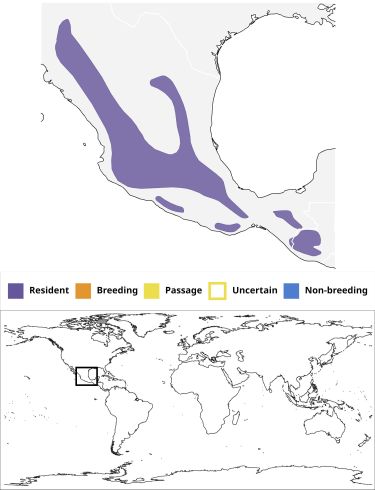- Empidonax affinis
Identification
13 - 14.5 cm.
- Pale greyish lores
- Whitish teardrop-shaped eye-ring, extending to point behind eye
- Grey to greyish-olive crown, head side, nape and upperparts
- Dusky wings with whitish to buff wingbars
- Dusky tail
- Low contrast whitish or greyish throat
- Greyish chest and belly, often not distinct differently coloured to throat
- Whitish vent
Sexes similar. Juveniles have buffy wingbars.
Similar species
Has a narrower bill and is generally slimmer and longer-winged than Western Flycatcher. Pine is generally greyish instead of yellowish; its eyering is whitish rather than yellowish. Also note the less contrasting wingbars: pale fringes may be largely absent from the tertials but are often obvious in Western Flycatcher. As with most Empidonax Flycatcher the vocalisation is a main key for identification.
Likely to overlap with Acadian Flycatcher, Alder Flycatcher, Buff-breasted Flycatcher, Dusky Flycatcher, Gray Flycatcher, Hammond's Flycatcher, Least Flycatcher, Western Flycatcher, White-throated Flycatcher, Willow Flycatcher, Yellow-bellied Flycatcher, Yellowish Flycatcher.
See also Empidonax.
Distribution
Guatemala and Mexico.
A fairly common but localized species.
Taxonomy
Some vocal differences between populations south and north of the Isthmus of Tehuantepec (Mexico) indicate that more than one species may be involved.
Subspecies
Clements recognises the following subspecies [1]:
- E. a. pulverius in oak-pine forests of northwest Mexico (Sinaloa to Jalisco)
- E. a. trepidus in northern Mexico (Coahuila and Tamaulipas); winters to Guatemala
- E. a. affinis in pine forests of Mexican plateau (Michoacán to Puebla)
- E. a. bairdi in pine forests of south Mexico (Guerrero, Oaxaca and Chiapas)
- E. a. vigensis in oak-pine forests of east Mexico (Veracruz)
Habitat
Pine-oak forest from 1600 to 3500 m.
Behaviour
Diet
Feeds on insects.
Forages similar to Hammond's Flycatcher at all levels of forest.
Breeding
Poorly known. Territorial birds reported in Chiapas in late May. The nest is a cup placed in a tree fork at middle level of the forest.
Movements
Mainly a resident species. Some local wandering in autumn and winter, particularly birds in the northern parts of its range.
References
- Clements, J. F., T. S. Schulenberg, M. J. Iliff, D. Roberson, T. A. Fredericks, B. L. Sullivan, and C. L. Wood. 2015. The eBird/Clements checklist of birds of the world: v2015, with updates to August 2015. Downloaded from http://www.birds.cornell.edu/clementschecklist/download/
- Gill, F and D Donsker (Eds). 2015. IOC World Bird Names (version 5.2). Available at http://www.worldbirdnames.org/.
- Handbook of the Birds of the World Alive (retrieved June 2015)
Recommended Citation
- BirdForum Opus contributors. (2025) Pine Flycatcher. In: BirdForum, the forum for wild birds and birding. Retrieved 5 January 2025 from https://www.birdforum.net/opus/Pine_Flycatcher





